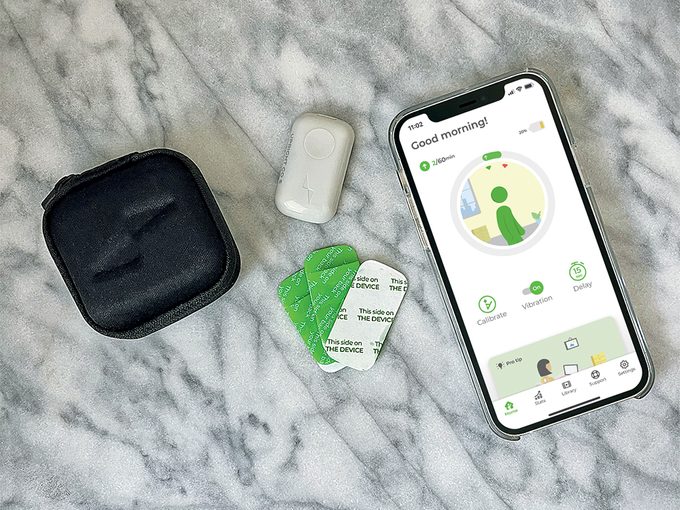I Tried the Upright Posture Trainer—Here’s What Happened

Can the Upright device help me adopt a statuesque stance, or does it have limitations? An expert shares her thoughts.
I was eight years old, sitting at the dinner table with my family, when my grandmother slipped her arm around me and pressed her knuckle straight into the small of my back. I jolted upright—exactly as she intended. It would be the first of many swift jabs whenever she’d catch me slouching. And it worked: I developed a habit, which lasted for years, of correcting my posture throughout the day, no knuckle necessary.
But then the pandemic came, and as life as we knew it fizzled away, so did my good posture. I was worried I’d developed a bit of a hunched stance and needed a new reminder to straighten up. And that’s when I scrolled upon Upright’s posture training device.
The 3.8-centimetre gadget, which can be worn as a necklace or stuck on your back with disposable adhesives, has a sensor that can detect a slouch. It links to your phone to track your posture via the brand’s app; a little graphic mimics your body’s position, so when you hunch you’ll see a slanted figure. Hunch too far, and the device on your back vibrates as a gentle reprimand—not unlike an electric fence that gives disobedient dogs a little shock.

Sitting at my desk, I stuck the device onto my back, set the timer on the app for 60 minutes and assumed a regal stance. My goal was never to let the device vibrate. So when I had a hard time reading a document on my computer, I didn’t lean forward; I moved my screen closer. When I had to grab something off the ground, I didn’t stoop down; I lowered myself via plié. On the few occasions when I forgot about the device and was vibrated back into compliance, I felt like a scolded dog and retreated into a frozen position.
Each day, I increased my goal on the Upright device, hoping I’d soon default to good posture. While the device was certainly an effective reminder, I wondered if it was enough. What about the other elements it wasn’t able to track, like my squared shoulders and my alignment?
“When aiming for perfect posture, the back is actually the least important body part to focus on,” says Dr. Liza Egbogah, a Toronto-based osteopath and chiropractor. Instead, she says I should focus on my front, since tightness there causes the body to pull forward into a croissant shape.
With her clients, Egbogah uses massage techniques to loosen their chest, fascia around the neck, pec muscles and hip flexors, making it easier for them to pull their shoulders back, sit up straighter and maintain that pose, as well as to reduce body aches. “When your body is out of alignment, there’s going to be an impact on your joints,” she says. This can lead to faster degeneration of joints, causing pain and even early-onset arthritis.
A tool like the Upright device can be beneficial, Egbogah says, as long as it’s treated as a posture reminder, not a corrector. That means before using it, Egbogah recommends understanding what “good posture” means: ears in line with shoulders, shoulders in line with hip bones and hip bones in line with the outer parts of the ankles. Then, ease tightness in the body by using a lacrosse ball or foam roller.
Performing short, simple stretches throughout the day is also key for addressing tightness. Egbogah says that when she sits at her desk, she simply pulls back her shoulders every hour or so. When standing in line at a store, she crosses her arms behind her back to open her chest.
Once your body’s loosened up, Egbogah suggests going slow with the Upright device; like building up muscle, improving posture takes time. She recommends using it for just one or two hours a day, preferably in the afternoon, when muscles have likely fatigued.
On the days I use the posture corrector and stretch my body, I find it’s less work to keep my back straight. The more I use my foam roller, the easier it is to keep my body in alignment. And the more attention I pay to my posture, the better I feel. I knew good posture was an easy confidence booster, but I was surprised to learn it’s a mood booster, too: Studies have shown it can decrease stress, anxiety and depression.
Recently, my boyfriend commented on my excellent posture and told me I looked taller. “Maybe I should get this thing,” he said, gesturing to the Upright. “No need,” I told him, pressing my knuckle into his back. “I got you covered.”




